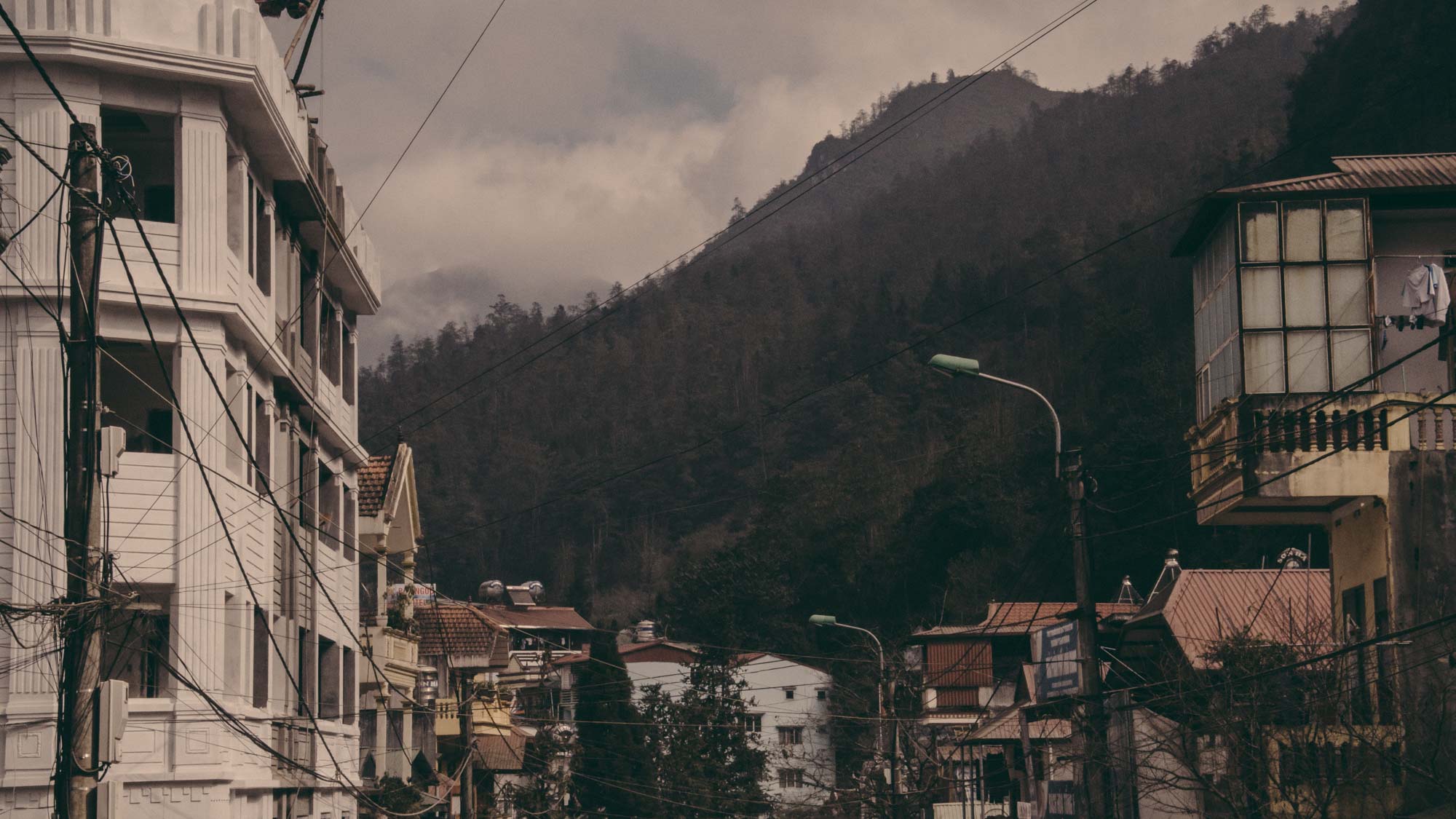December 5th – 2:15pm local time – Nhat Linh Hotel rooftop, Sapa
A briskly early wake-up in yet another windowless city hotel room could not be a more distant setting from where we are now. We’ve arrived in by far one of the most scenic of places we’ve ever seen.
Yesterday morning, we gathered our things and awaited our bus pickup to the mountain town of Sapa from our hotel lobby. With a few minutes to spare we make a quick run to a corner store for a pair of tweezers to (hopefully) help fix our broken camera gear situation, large bottles of water and emergency chocolate bars for the half-day bus ride ahead. Our pickup shuttle is right on time for 6:45am.
We pile in with a bunch of other tourists – a rather unfamiliar sight at this point in our self-directed trip – and make our way to the bus depot, which is nothing more than a dirt lot a few blocks away with a bunch of other stationed tour busses. The bus layout is welcome yet strange. Three rows of bunks, all of which host a laid back seat padded and primed for sleeping. Each seat has its own window, curtains, and front table. Space is tight, so everyone lays their bags in the rows to avoid spooning or straddling them the entire journey. There are no screens, but they do have painstakingly slow Wi-Fi. Nonetheless, we’re happy to have found a comfortable means of travel for the long voyage ahead.
After a couple hours of sleeping and attempting to snap some photos from our mobile motel (which only cost us $15 USD per ticket) the bus makes a stop in what appears to be the middle of nowhere at an extravagantly large yet lightly occupied dining hall. The food appears questionable, so we pick out the meat just to be sure. Better to play it safe considering we’ve got another 5 hours of bus ride ahead. We clamber back into our sleeping berths and pass the time catching up on some sleep. That is, until we start the climb into the mountains, which only a fool could have slept through.
Hardly any combination of words can do justice to the countryside’s beauty. Over the edge of the mountainous road we see a river splitting the terrain of steep looming rice fields and lush hillsides, cascading down to the valley bottom. Boulders and waterfalls divide the course of the stream as the sun breaks through the clouds and beats down upon the mountainside. We are truly speechless as the terrain before us presents itself in the most dominant fashion. Truly humbling this view is. Our awe extends for a 36km uphill ride of sheer bliss, absorbing the tenacious glory of the countryside. Vietnam has once again surprised us beyond description.
Finally arrived in Sapa at the top of the road, we’re immediately swarmed by tribes-folk from the hills whom the region is famous for as we step off the bus. They vigorously offer to take us on an escapade through the mountains to stay in their village for indulgence in ‘happy leaves and happy water’. Politely and patiently turning them away, we saunter briefly up the street to find ourselves a place of accommodation. Fate smiles upon us as we come across a $20 USD per night room, the largest, cleanest, and most modern we have yet to see in Vietnam, with a delightful view of the opposing mountains and citadels lining the man-made lake at the center of town.
Wasting no time, we take to the streets to document this colourful and European-looking area. It feels as though we’re in the Swiss alps, or, for a closer and more familiar comparison, Canada’s Banff village. The architecture around us is predominantly French, as they developed the area for tourism in the early 1900's, along with other European influences. The flow of Sapa’s design is interrupted by the trademark communist citadels we’ve begun to notice in every area we visit. They are seemingly unoccupied and instead serve the purpose of keeping ideology top of mind.
The people here are full of life, both local and indigenous alike. Though this is not surprising given the majesty of our surroundings. Every step we take brings new delights as we attempt to fathom our foreground. In no realm of possibility could we have ever imaged a place such as this existing on this Earth, let alone in this country.
We make our way through town to the tourist strip for some dinner and take a seat on a delightful little patio where we meet three Israeli women – Karen, Mila and Lana – and a peculiar Australian named Will. The night passes by quickly in a furor of storytelling, drinking and laughing. While being accosted by the tribeswomen from the surrounding mountains to purchase their hand-crafted goods, we ponder their current state of affairs.
Presumably, these indigenous peoples must have at some point been self-sustaining tribes, relying on trade for goods that were outside their means of production. Now, they make their way into town to sell their wares in exchange for currency, which seems rather odd. Why would a tribe who makes their homes in the mountainous distance require such economic means? We can only theorize that this is derived from the outside influences which have severed their previous way of life, forcing them to now engage in the currency-driven economy fueled by tourism. Once again we speculate and analyze the impact of our visitation to this country and that of those before us.
As much as we gain perspective on these matters through our exploration of the unknown, it’s evident that our doing so is what contributes to the perpetuation of this cyclical issue. But now, if tourism were to withdraw from Vietnam in its entirety it would likely flat-line their economy. Would such a withdrawal allow for the people of Vietnam to redefine themselves and rebuild their means of sustenance? Questions such as these flurry about and remain largely unanswered. We can only hope that asking such questions helps shape the approach to our travels and our views of the world in which we live. Perhaps a visit to the local museum will shed some light on these unknown peoples and the coming about of their way of life.
Down the street from our hotel at the Spider Bar we wrap things up with some shisha and beers, accompanied by our newfound friend and eccentric artist, Will. Utopian possibilities, innermost fears and dreams, and much more are laid out on the table like playing cards as our verbal exchange becomes the soundtrack to our evening.
December 6th – 11:52am local time – Nhat Linh Hotel rooftop, Sapa
The next day we woke to the most golden of sunrises draping the surrounding mountains. Wasting no time to take advantage of this amazing weather we meet up with Will, grab some scooters, and plan to hike the Cat Cat village trail before riding up to the Fansipan cable car to get a glimpse of the town from the highest point in all of Vietnam. Unfortunately, moments after rented our scooters were rented we got separated from Will. Our attempts to find him fell short as we made our way up and down the tourist strip a few times. Unable to get in contact with him, we decide to push on into the day and hope that he manages to occupy his rental time well.
A breathtaking café shows itself as we make our way towards the Cat Cat trail, so we stop for lunch to appreciate the view before pressing onward; an adequate appetizer for what lies ahead. Arrived at the entrance to the short trek, we park our scooters and make our way down the cobblestone steps into the village. The path is lined with tribe members selling wares varying from scarves to swords. “Buy something please” is a commonly heard phrase throughout our descent. Pigs, chicken, ducks, and dogs pay us no notice as they feed and saunter about along the path’s edges.
The steps steepen as the landscape opens up revealing a small river accented by boulders and water-wheels before dropping under a footbridge and widening to a beautiful waterfall carving its way into the hillside. The mist on our faces is a welcomed feeling in the battering sunlight. As we venture further, the path narrows and starts ascending the mountainside with no guard rails or safety measures in place whatsoever. We take advantage of this to break away and explore the riverbed below before making the final ascent on the opposite side of the valley, providing astounding views of the rice fields below. We’re in awe of Sapa’s beauty once again.
Back at our bikes, we make quick work of finding a restaurant for lunch on the tiny tourist strip before proceeding with our plan to visit the Fansipan peak via the more than 6km long Guinness world record-holding gondola. The ride up the hillside is unsurprisingly beautiful, winding along the edge of the mountain until spitting us out at an overwhelmingly large and relatively new tourism centre. Anticipation builds as we set foot into an empty gondola for a practically private ride across the valley to the opposing peak. The traverse is daunting as we remain suspended hundreds of feet above the ground inching our way closer to the peak to watch the sun set. Once again, we’re graced with incredible views of the valley and surrounding mountains.
Arrived on the other side, we’re met by a looming and large set of stairs leading to the peak; something we didn’t quite expect. The altitude takes its toll almost immediately as we begin the climb, shortening our breath with every step. Hundreds of stairs lead the way while we take short breaks to absorb the scenery from this new perspective. The backside of the mountain, unbeknownst to us until now, is dramatically steep and hosts lovely little wisps of clouds dancing around the edges of the cliffs. Finally, at the top of Fansipan over 3100 metres above sea level, the view takes away what’s left of our already feeble breaths. It’s at this point that words can do no justice to the scene laid before us.
Never in our lives have we seen something so majestic and humbling. The peaks stretch as far as the eye can see in every direction, boasting their beauty subtly and sincerely. The sun begins to dip below the haze in the distance as the air around us turns gold and pink, tinging the clouds and vividly staining our memories like glass in the most pristine of chapels. We stand in amazement for as long as we can before the sun takes its leave and the winds of the peak grip us firmly with their sharp cold. The workers are kind enough to offer us some of their tea to help keep us warm until we decide to finally begin the ascent down the beautiful staircases toward the cable car.
No force of nature could possibly wash away the euphoria that consumes us at this moment. Sapa has taken a permanent place in our minds and hearts.
Words by Baylan McGraw














































































